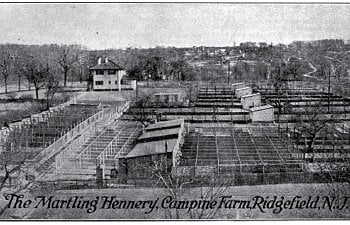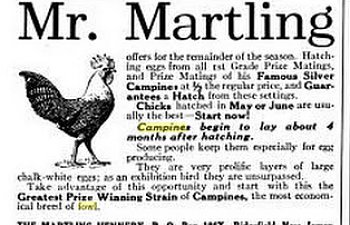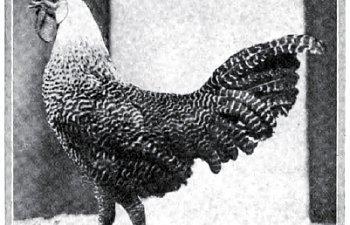A Village Poultry Plant
by C.S. Valentine
(Country Life in America; August 1916)
When the latest United States census enumerated poultry, it took no account of any except that kept on farms, and thereby committed an egrarious blunder. Not only are large numbers of poultry kept in towns and villages, and to a lesser extent, in cities, but some of the best and most valuable birds are here found. When it comes to the largest specialty farm for a single breed in the midst of a village of less than 2000 souls, it would appear that not all the bird values are on so-called farms. Such a plant has much of interest and instruction in the details which I obtained from Mr. S.V.R, Martling, the owner and working manager.
It covers, probably, three or four acres on high ground with a westerly slope giving good drainage. The long houses facing the south and extending up and down the slope are of a familiar shed-roofed type, but very durably and substantially constructed, and stepped to conform to the slope. They are high enough in front to give ample head room, and here one passes from pen to pen. There are no alleys or wasted space. The roosting platforms and with nests suspended under them are at the back. The inside is double boarded up the back and over the roosts, while under the eaves a narrow, hinged drop board opens, giving ventilation when needed, with no drafts.
Practically the whole area is covered with houses and yards, except the grounds around the residence, and the basement of the latter houses the incubators, packing-room, oats sprouters, and storage room. Houses and yards are on both sides of a runway extending through the centre. The plant is run, not as a fad, but solely as a business proposition, for the production of the best Campines that long study, hard work, skill, and years of experience can produce. Yet the fact is not lost sight of that, back of this, must be health, vigor, and strong constitutions, so that those birds lacking in the points necessary for show birds may have the size and stamina to make good business layers. Careful records are kept of the line breeding so that intelligent selections of birds may be made at any time for any purpose. Some of the practices are radical, but experience has proved their value.
The packing table is a model of convenience. Underneath it are two large drawers, one containing bran and the other excelsior. The eggs are packed in wooden boxes holding fifteen, with double pasteboard fillers, and with sliding covers. After the eggs are placed in compartments, bran is shaken around until every egg is completely imbedded in it. Then this box, surrounded with excelsior, is placed in a covered, handled basket, the cover tied on, the basket carefully corded so there is no possibility of damage unless the basket is smashed. Mr. Martling says that it costs 50 cents per setting to pack in this thorough way, but that it pays.
Eggs from special matings and others not required to fill orders are incubated in ordinary small, gas heated incubators; sand trays are used, and the eggs are sprinkled just before the end of the hatch. Special mating eggs are put into pedigree trays, and every chick is banded so that a record may be kept of its ancestry. The bands are changed for larger ones as the chicks grow. The chicks are raised in outdoor brooders, afterward being put into colony houses with large yards attached, the latter being sowed with rape and possibly some other crop. This sweetens the ground and furnishes succulent feed.
Sprouted oats are fed to all birds once daily. No patent sprouters are used, but large, flat boxes such as are used for packing cereals, each holding about one bushel. These are mounted in a frame, like drawers, and slide in and out. The bottoms are of narrow strips, about one quart inch apart, the cracks nearly closing from the moisture when frames are in use. The oats are sprinkled and stirred twice daily, and the product is a wholesome mass of tender roots and sprouts which are all consumed with relish and benefit. No formaldehyde is needed on oats as treated as these are. Cabbages are also feed during a part of the year.
The floors of the house are all heavily bedded with pine shavings and rye straw in which a small quantity of scratch feed is thrown twice daily. Automatic feeders also scatter grain on demand. Mr. Martling says that some males are so intent on scratching for their hens and feeding them, that they do not get enough themselves to keep in condition, and it is necessary to feed them separately.
This scratch feed is made up about as follows:
Oats, 320 pounds
Cracked Corn, 200 pounds
Kafir Corn, 100 pounds
Buckwheat, 55 pounds
Barley, 400 pounds
Wheat, 500 pounds
It will be noticed that the proportions of the fattening grains, corn and buckwheat, are very small. The quantities given are those purchased for one month for approximately 900 birds, but really lasting more than a week into the next month, and this at the season of heaviest egg production. The different grains are purchased at the local dealers, and thoroughly inspected and found to be all right before mixing.
The dry mash for the same period is made up as follows:
Bran, 150 pounds
Ground Oats, 128 pounds
Middlings, 100 pounds
Oil Meal, 17 pounds
Alfalfa Meal, 50 pounds
Beef scrap, 75 pounds
For the first five or six weeks the chicks are fed on a special commercial chick feed, and are not encouraged to scratch. After that, they are given mixed grain chick feed in litter. The chicks are fed every two hours.
Some of the birds in the utility class are housed in semi-detached colony houses in large yards. The special breeding pens are in the long houses with air sized yards on each side for each pen of birds. For every two yards, a larger grassy paddock is provided, into which each pen is admitted on alternate days, thus affording considerable range. Everything about the buildings and yards is kept scrupulously clean, and health is a leading consideration. The runs are all wire covered. All the yards and houses are guarded by an electric circuit through which 500 volts are passing all night. This service is inexpensive but effective.
Were I to guess at the secret of the success of this plant – that is, if there is any secret about it – I should say that it lies in the choice of a single breed personally pleasing to the owner, close application of business principles, thorough supervision in every detail, strict cleanliness, and the determination to make every customer a pleased customer.
The Campine Fowls:
Campines have been bred for centuries as utility fowls, especially for egg production, in the rigorous climate of Belgium. In comparatively recent times, they were brought first to England and then to this country. They are extremely hardy, active and alert. The body is deep and long, back long and rather flat. They are closely feathered and heavier than their appearance indicates. Standard weights are: cock, 6 pounds, cockerel, 5 pounds, hen, 4 pounds, pullet, 3 ½ pounds. These are the same as Leghorn weights for females, and a half pound more for males.
The Campines were formerly in the American standard, but interest in them declined to such an extent that they were dropped. Later they again attracted attention, and the number of their admirers has considerably increased. They have been again admitted, and have a class to themselves, the Continental. They are handsome birds when well bred, but some say that they are harder to breed true than are Barred Rocks, though the utility birds are easily raised. Males and females have the same markings, and single mating may be followed. The primary colors of the plumage are black and white, the black with a beetle green sheen. The markings are well shown in the illustrations. They have single combs, but of medium size. The shanks are leaden blue in color.
Not only are the hens prolific layers of white eggs, but the claim is made that well-grown, mature birds lay the largest eggs of any breed of fowl.
Breeders say that the problem in feeding Campines is not to overfeed, as they are easy keepers and small eaters, and may very easily be made too fat to be in the best laying condition. It is claimed that the Campines can be kept in the pink of laying condition on two thirds the feed required for Leghorns. If this be proved true in general practice, it will be a strong point in their favor in these times of high prices.
The Silver Campine is the variety most largely kept in this country. The Golden has not been so long and carefully bred, but is being improved by its admirers. It is the same as the Silver except that it is golden bay where the other is is white. Both varieties offer an inviting field for the skill of the fancier as well as for the utility poultry man.
Online Resources on Silver & Golden Campines
Books about Campines (from Amazon.com):
The Campine Fowl by Mrs. J Harvey
https://www.amazon.com/Campine-Fowl-Chicken-Breeds-Book/dp/1542830907/
The Campine Fowl History by Rev. B.A. Gates
https://www.amazon.com/Campine-Fowl-History-Chicken-Breeds/dp/1542760984/
Silver and Golden Campine Chickens by F.L. Platt
https://www.amazon.com/Silver-Golden-Campine-Chickens-Chicken/dp/153340061X/
The Vigorous Strain of Silver Campine Chickens by C.A. Phipps
https://www.amazon.com/Vigorous-Strain-Silver-Campine-Chickens/dp/1542776597
The Poultry Industry in Belgium by Edward Brown
https://www.amazon.com/Poultry-Industry-Belgium-Edward-Brown/dp/1542831326
Specialty Clubs:
Campine Club of Belgium - http://www.campines.be/
Campine Club of Australia - http://www.campines.org/
Facebook Groups:
Campine Chickens in Europe - https://www.facebook.com/groups/campinechicken/
Campine Breeders & Exhibitors - https://www.facebook.com/groups/1703257799906719/
Campines Australia - https://www.facebook.com/groups/200594576781492/
Facebook Pages:
Campines (in Dutch) - https://www.facebook.com/CampinesKempischHoen/
American Campinists - https://www.facebook.com/RarePoultryWarriors/
Golden Campine Chickens - https://www.facebook.com/GoldenCampineChickens
Silver Campine Chickens - https://www.facebook.com/Silver-Campine-Chickens-1952535771552790/
Websites about Campines:
Campines: The Original Everyday Layers - Exceptional site from Belgium (in English) on the history of Campines - http://campines.tumblr.com/
Campine or Brakel? - http://chickenoverload.tripod.com/chooks/id1.html
by C.S. Valentine
(Country Life in America; August 1916)
When the latest United States census enumerated poultry, it took no account of any except that kept on farms, and thereby committed an egrarious blunder. Not only are large numbers of poultry kept in towns and villages, and to a lesser extent, in cities, but some of the best and most valuable birds are here found. When it comes to the largest specialty farm for a single breed in the midst of a village of less than 2000 souls, it would appear that not all the bird values are on so-called farms. Such a plant has much of interest and instruction in the details which I obtained from Mr. S.V.R, Martling, the owner and working manager.
It covers, probably, three or four acres on high ground with a westerly slope giving good drainage. The long houses facing the south and extending up and down the slope are of a familiar shed-roofed type, but very durably and substantially constructed, and stepped to conform to the slope. They are high enough in front to give ample head room, and here one passes from pen to pen. There are no alleys or wasted space. The roosting platforms and with nests suspended under them are at the back. The inside is double boarded up the back and over the roosts, while under the eaves a narrow, hinged drop board opens, giving ventilation when needed, with no drafts.
Practically the whole area is covered with houses and yards, except the grounds around the residence, and the basement of the latter houses the incubators, packing-room, oats sprouters, and storage room. Houses and yards are on both sides of a runway extending through the centre. The plant is run, not as a fad, but solely as a business proposition, for the production of the best Campines that long study, hard work, skill, and years of experience can produce. Yet the fact is not lost sight of that, back of this, must be health, vigor, and strong constitutions, so that those birds lacking in the points necessary for show birds may have the size and stamina to make good business layers. Careful records are kept of the line breeding so that intelligent selections of birds may be made at any time for any purpose. Some of the practices are radical, but experience has proved their value.
The packing table is a model of convenience. Underneath it are two large drawers, one containing bran and the other excelsior. The eggs are packed in wooden boxes holding fifteen, with double pasteboard fillers, and with sliding covers. After the eggs are placed in compartments, bran is shaken around until every egg is completely imbedded in it. Then this box, surrounded with excelsior, is placed in a covered, handled basket, the cover tied on, the basket carefully corded so there is no possibility of damage unless the basket is smashed. Mr. Martling says that it costs 50 cents per setting to pack in this thorough way, but that it pays.
Eggs from special matings and others not required to fill orders are incubated in ordinary small, gas heated incubators; sand trays are used, and the eggs are sprinkled just before the end of the hatch. Special mating eggs are put into pedigree trays, and every chick is banded so that a record may be kept of its ancestry. The bands are changed for larger ones as the chicks grow. The chicks are raised in outdoor brooders, afterward being put into colony houses with large yards attached, the latter being sowed with rape and possibly some other crop. This sweetens the ground and furnishes succulent feed.
Sprouted oats are fed to all birds once daily. No patent sprouters are used, but large, flat boxes such as are used for packing cereals, each holding about one bushel. These are mounted in a frame, like drawers, and slide in and out. The bottoms are of narrow strips, about one quart inch apart, the cracks nearly closing from the moisture when frames are in use. The oats are sprinkled and stirred twice daily, and the product is a wholesome mass of tender roots and sprouts which are all consumed with relish and benefit. No formaldehyde is needed on oats as treated as these are. Cabbages are also feed during a part of the year.
The floors of the house are all heavily bedded with pine shavings and rye straw in which a small quantity of scratch feed is thrown twice daily. Automatic feeders also scatter grain on demand. Mr. Martling says that some males are so intent on scratching for their hens and feeding them, that they do not get enough themselves to keep in condition, and it is necessary to feed them separately.
This scratch feed is made up about as follows:
Oats, 320 pounds
Cracked Corn, 200 pounds
Kafir Corn, 100 pounds
Buckwheat, 55 pounds
Barley, 400 pounds
Wheat, 500 pounds
It will be noticed that the proportions of the fattening grains, corn and buckwheat, are very small. The quantities given are those purchased for one month for approximately 900 birds, but really lasting more than a week into the next month, and this at the season of heaviest egg production. The different grains are purchased at the local dealers, and thoroughly inspected and found to be all right before mixing.
The dry mash for the same period is made up as follows:
Bran, 150 pounds
Ground Oats, 128 pounds
Middlings, 100 pounds
Oil Meal, 17 pounds
Alfalfa Meal, 50 pounds
Beef scrap, 75 pounds
For the first five or six weeks the chicks are fed on a special commercial chick feed, and are not encouraged to scratch. After that, they are given mixed grain chick feed in litter. The chicks are fed every two hours.
Some of the birds in the utility class are housed in semi-detached colony houses in large yards. The special breeding pens are in the long houses with air sized yards on each side for each pen of birds. For every two yards, a larger grassy paddock is provided, into which each pen is admitted on alternate days, thus affording considerable range. Everything about the buildings and yards is kept scrupulously clean, and health is a leading consideration. The runs are all wire covered. All the yards and houses are guarded by an electric circuit through which 500 volts are passing all night. This service is inexpensive but effective.
Were I to guess at the secret of the success of this plant – that is, if there is any secret about it – I should say that it lies in the choice of a single breed personally pleasing to the owner, close application of business principles, thorough supervision in every detail, strict cleanliness, and the determination to make every customer a pleased customer.
The Campine Fowls:
Campines have been bred for centuries as utility fowls, especially for egg production, in the rigorous climate of Belgium. In comparatively recent times, they were brought first to England and then to this country. They are extremely hardy, active and alert. The body is deep and long, back long and rather flat. They are closely feathered and heavier than their appearance indicates. Standard weights are: cock, 6 pounds, cockerel, 5 pounds, hen, 4 pounds, pullet, 3 ½ pounds. These are the same as Leghorn weights for females, and a half pound more for males.
The Campines were formerly in the American standard, but interest in them declined to such an extent that they were dropped. Later they again attracted attention, and the number of their admirers has considerably increased. They have been again admitted, and have a class to themselves, the Continental. They are handsome birds when well bred, but some say that they are harder to breed true than are Barred Rocks, though the utility birds are easily raised. Males and females have the same markings, and single mating may be followed. The primary colors of the plumage are black and white, the black with a beetle green sheen. The markings are well shown in the illustrations. They have single combs, but of medium size. The shanks are leaden blue in color.
Not only are the hens prolific layers of white eggs, but the claim is made that well-grown, mature birds lay the largest eggs of any breed of fowl.
Breeders say that the problem in feeding Campines is not to overfeed, as they are easy keepers and small eaters, and may very easily be made too fat to be in the best laying condition. It is claimed that the Campines can be kept in the pink of laying condition on two thirds the feed required for Leghorns. If this be proved true in general practice, it will be a strong point in their favor in these times of high prices.
The Silver Campine is the variety most largely kept in this country. The Golden has not been so long and carefully bred, but is being improved by its admirers. It is the same as the Silver except that it is golden bay where the other is is white. Both varieties offer an inviting field for the skill of the fancier as well as for the utility poultry man.
Online Resources on Silver & Golden Campines
Books about Campines (from Amazon.com):
The Campine Fowl by Mrs. J Harvey
https://www.amazon.com/Campine-Fowl-Chicken-Breeds-Book/dp/1542830907/
The Campine Fowl History by Rev. B.A. Gates
https://www.amazon.com/Campine-Fowl-History-Chicken-Breeds/dp/1542760984/
Silver and Golden Campine Chickens by F.L. Platt
https://www.amazon.com/Silver-Golden-Campine-Chickens-Chicken/dp/153340061X/
The Vigorous Strain of Silver Campine Chickens by C.A. Phipps
https://www.amazon.com/Vigorous-Strain-Silver-Campine-Chickens/dp/1542776597
The Poultry Industry in Belgium by Edward Brown
https://www.amazon.com/Poultry-Industry-Belgium-Edward-Brown/dp/1542831326
Specialty Clubs:
Campine Club of Belgium - http://www.campines.be/
Campine Club of Australia - http://www.campines.org/
Facebook Groups:
Campine Chickens in Europe - https://www.facebook.com/groups/campinechicken/
Campine Breeders & Exhibitors - https://www.facebook.com/groups/1703257799906719/
Campines Australia - https://www.facebook.com/groups/200594576781492/
Facebook Pages:
Campines (in Dutch) - https://www.facebook.com/CampinesKempischHoen/
American Campinists - https://www.facebook.com/RarePoultryWarriors/
Golden Campine Chickens - https://www.facebook.com/GoldenCampineChickens
Silver Campine Chickens - https://www.facebook.com/Silver-Campine-Chickens-1952535771552790/
Websites about Campines:
Campines: The Original Everyday Layers - Exceptional site from Belgium (in English) on the history of Campines - http://campines.tumblr.com/
Campine or Brakel? - http://chickenoverload.tripod.com/chooks/id1.html




